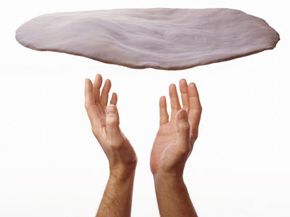“
 “Dough tossing looks like so much fun. Learn more by checking out these international tomato recipes pictures.Last Resort/Getty Images
“Dough tossing looks like so much fun. Learn more by checking out these international tomato recipes pictures.Last Resort/Getty Images
Have you ever stopped at into your local pizza joint to pick up a pie, and found yourself entranced by the guys in the back, tossing and spinning dough in the air? As you watch them throw the pliable dough above their heads, catching it safely in their hands with seemingly no effort, do you ever wish you could do it, too? Well, here’s how.
Not Just for Fun
It might seem like tossing pizza dough is showboating — a fancy way to shape and stretch out pizza dough to fit the pan. But dough tossing isn’t just cool to watch, it’s actually the gentlest way to form a crust. Some pizza manufacturers use a machine press or dough sheeter to form pizza crust. These techniques are efficient, but the dough dries out more, which results in a crunchier crust. When dough is tossed by hand, it doesn’t lose quite as much moisture, so the crust is softer.
In fact, managing the moisture of the dough is the trick to tossing. Spinning the dough through the air helps create that round shape, but in addition, the airflow over the dough’s surface dries it out just enough to make it less sticky and easier to handle. And the perfect amount of airflow makes for a perfectly crispy crust. Another benefit of hand-tossing is a non-uniform crumb. This means that every pizza crust is unique — tender in some spots and crisp in others. The outer edge of a hand-tossed pizza has a lighter and higher crust than those formed by other methods (like machine or press).
So now that you know why you should hand toss your dough, let’s talk about how you do it.
How to Toss the Dough
- You can use homemade or store-bought dough. As long as it was made with yeast, it’s fine for tossing.
- Prep your work area with flour. Keep a bowl nearby.
- Remove any jewelry from your hands.
- Dough should be room temperature and shaped into a ball. Dust with flour.
- Press out the dough with your hands to form a disc about 10 inches (25.4 centimeters) across and a half-inch (1.27 centimeters) thick. You can also use a rolling pin.
- Pick up the dough and drape it over your hands. One hand should be palm up, the other in a fist.
- Use the hand with the palm up to lift and spin the dough into the air. You don’t have to toss it high, just enough to get a rotation in.
- Catch the dough on the backs of your fists, which provide a flatter and more stable area than your palm and fingers would.
- Repeat until the dough stretches to the desired size, usually around 12 inches (30.5 centimeters).
Things to Know
- If you’re right-handed, use that hand palm-up. That’s your "throwing hand." Same thing if you’re left-handed.
- Your fingers should always be closed — don’t spread them apart.
- As the dough stretches and grows, adjust for the difference by moving your hands further apart.
- Dough with good gluten development is best for tossing. Whole-wheat crusts are usually low in gluten and may not work well. Use a mixture of wheat and white flours for the best results.
Don’t expect to become an expert after the first try. You may have to adjust your recipe and technique before achieving the perfect toss. Remember, practice makes perfect!
Did you know?
You can buy fake dough to practice your tossing techniques. Really! Or, just practice with a damp dishtowel.
Lots More Information
Related HowStuffWorks Articles
- How does childhood obesity work?
- How Locavores Work
- How Organic Certification Works
- How Organic Farming Works
- How Organic Food Works
- Is it better to buy local or organic food?
- What are genetically modified (GM) foods?
Sources
- "Easy Whole Wheat Pizza Dough." EatingWell Magazine. July 2008. http://www.eatingwell.com/recipes/easy_wheat_pizza_dough.html
- Gemignani, Tony. "Tossing Dough." Feb. 5, 2009. http://www.youtube.com/watch?v=HWL__9yDu8I
- Henley, Bill. "Pizzeria co-owner carves out niche with flick of the wrist." The Post and Courier. June 18, 2009. http://www.postandcourier.com/news/2009/jun/18/suonthejobs86297/
- Lehman, Tom. "All doughs are not created equal." Pizza Marketing Quarterly. 2002. http://www.prodoughusa.com/doughforming.html


